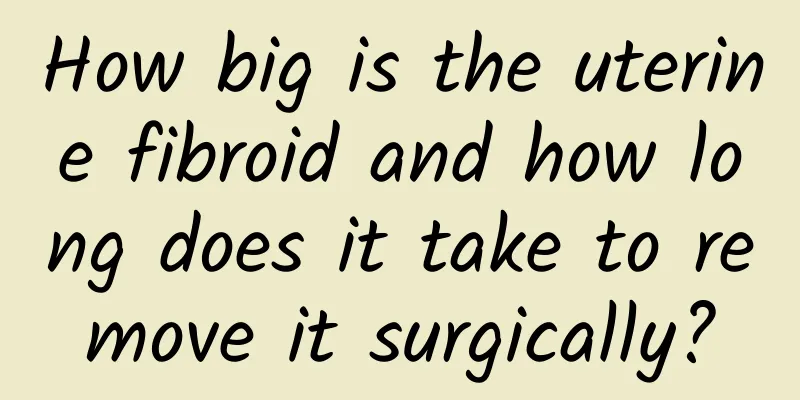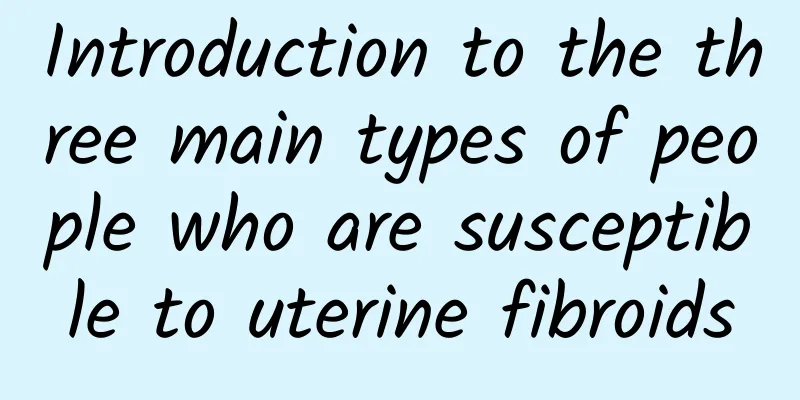How big is the uterine fibroid and how long does it take to remove it surgically?

|
Generally, surgery is recommended when the diameter of uterine fibroids exceeds 5 cm, but not all cases require immediate removal. The necessity of surgery depends not only on the size of the fibroids, but also on the patient's specific symptoms and health status. The time of surgery is not fixed either. The time will vary depending on the surgical method, such as open surgery or laparoscopic surgery. 1. Fibroid size and necessity of surgery The size of the uterine fibroid is an important factor in deciding whether to have surgery, but it is not the only one. Surgery is usually recommended for fibroids larger than 5 cm, especially when the fibroids cause obvious symptoms, such as heavy menstrual bleeding, severe abdominal pain, or pressure on surrounding organs. However, whether surgery is necessary also needs to be considered, such as the patient's fertility plan, age, and the growth rate of the fibroids. 2. Symptoms and surgical indications Surgery may be necessary when uterine fibroids cause heavy menstrual bleeding and anemia, and medical treatment is ineffective. Other situations where surgery may be considered include: severe abdominal pain, dyspareunia, chronic abdominal pain, acute abdominal pain caused by torsion of the fibroid, or discomfort caused by fibroids pressing on organs such as the bladder and rectum. Surgery should also be considered if fibroids are confirmed to be the only cause of infertility or recurrent miscarriage, or if there is a suspicion that the fibroids may become malignant. 3. Surgical method and time The choice of surgical method will affect the operation time. Open surgery usually takes less time because the surgical field is wider and a variety of instruments can be used. Laparoscopic surgery requires more delicate operations and usually takes longer. The intraoperative situation will also affect the operation time, such as whether there are adhesions in the abdominal cavity. 4. Choice of surgical type For patients who wish to retain their fertility, myomectomy can be an option. Submucosal myomas or most intramural myomas that protrude into the uterine cavity can be removed through hysteroscopy, and submucosal myomas that protrude into the vagina can be removed vaginally. There is a 50% chance of recurrence after surgery, and about 1/3 of patients may need another surgery. 5. Applicable cases of hysterectomy When patients do not need to preserve their fertility or suspect that fibroids have become malignant, hysterectomy is an option, including total hysterectomy and subtotal hysterectomy. Before surgery, doctors usually perform cervical cytology to rule out the possibility of cervical intraepithelial neoplasia or cervical cancer. Especially in perimenopausal patients, be alert to the risk of combined endometrial cancer. The treatment of uterine fibroids requires comprehensive consideration of multiple factors, and surgery is only one of the options. Patients should fully communicate with their doctors and choose the most appropriate treatment plan based on their own situation. I hope this article can provide you with some help and inspiration. |
<<: How long should I stay in bed after laparotomy for uterine fibroids?
>>: What are the dangers of thick endometrium?
Recommend
What are the specific preventive measures for cervical erosion?
I believe that female friends do not want to suff...
What are the dangers of pelvic inflammatory disease
Pelvic inflammatory disease refers to inflammatio...
Vulvar itching infection route
Patients often ask: Is vulvitis contagious? What ...
Common causes of adnexitis in women
I believe that many people do not know the causes...
Is the endometrial thickness of 2.5 cm serious?
Whether an endometrial thickness of 2.5 cm is ser...
New cabbage variety is heat-resistant and can be grown in summer
Cabbage, commonly known as Korean cabbage, is lov...
5 tips to reduce sugar, slim belly and body fat, she lost 10 kilograms!
Even though you are physically tired, you often w...
How to maintain the uterus after miscarriage? Do these 4 things
Although there are many contraceptive methods tha...
What should I pay attention to after treating cervical erosion?
What should I pay attention to after treating cer...
What are the symptoms of congenital absence of vagina?
Congenital absence of vagina refers to the obstru...
What are the treatments for vulvar leukoplakia?
What are the treatments for vulvar leukoplakia? V...
Regular pre-abortion check-ups are especially important for women
Female abortion is a common surgery, and many wom...
To prevent ovarian cysts, you should pay attention to three major health care
The prevention of ovarian cysts must start with d...
How to better prevent vulvar day shift?
Now that we know what vulvar leukoplakia is, we a...
Are the symptoms of hyperprolactinemia obvious?
Hyperprolactinemia is a very common disease, whic...









